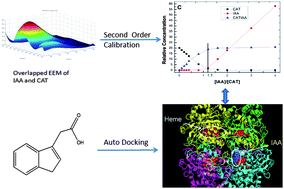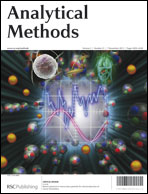Investigation of the interactions between indole-3-acetic acid and catalase: A spectroscopic study in combination with second-order calibration and molecular docking methods†
Abstract
The interactions between indole-3-acetic acid (IAA) and the important antioxidant enzyme catalase (CAT) have been studied by Ultraviolet-visible (UV-vis) and fluorescence spectroscopic methods. The decrease of the absorption intensity of CAT at 270 nm and 407 nm in UV-vis spectra with the addition of IAA indicated the interactions between CAT and IAA. The three-way excitation–emission matrix spectra combined with parallel factor analysis (PARAFAC) was used to provide the individual concentration information of IAA, CAT, and IAA–CAT in the reaction system. The PARAFAC analysis showed that a 1 : 1 IAA–CAT complex formed at the equilibrium point. Constant wavelength synchronous fluorescence spectrometry (SFS) showed that the binding of IAA resulted in the micro-environment changes around tryptophan (Trp) and tyrosine (Tyr) residues. Molecular docking studies provide a good structural basis to explain the experimental results. This work is valuable for providing a deeper insight into the interaction mechanism of IAA with CAT.


 Please wait while we load your content...
Please wait while we load your content...